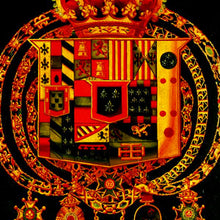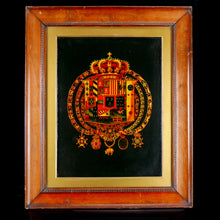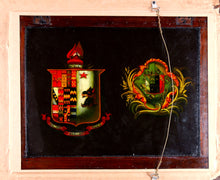Arms of Ferdinand I, King of Naples and Sicily, 1820
- Regular price
- £1,675
- Sale price
- £1,675
- Regular price
-
- Unit price
- /per
Adding product to your cart
Overall: 50cm (19.7in) 42cm (16.5in)
Oil on panel. The armorial achievement of Ferdinand I (1751-1825), King of the Two Sicilies following his restoration in 1816. Contained in a early 19th century glazed frame with two further heraldic artist’s designs verso.
Ferdinand (1751-1825), King of Naples and Sicily, was deposed twice from the throne of Naples: once by the revolutionary Parthenopean Republic for six months in 1799, and again by a French invasion in 1806, before being restored in 1815 at the end of the Napoleonic Wars. Ferdinand's kingdom, especially Naples, proved a valuable foothold for British Mediterranean operations from the start of the French Revolutionary War in 1793 until it was annexed by Napoleon in 1806. His astute and domineering queen, Maria Carolina of Austria (1752-1814) daughter of Francis I, Holy Roman Emperor and Maria Theresa, Queen of Bohemia and Hungary, Archduchess of Austria, was the sister of Queen Marie-Antoinette of France who was beheaded in 1793. The court at Naples and at the Sicilian capital, Palermo, was characterized by display and extravagance. Though popular with the Neapolitan mob, Ferdinand was mainly interested in hunting while the Queen was the controlling influence in government, manipulating Nelson through her friendship with Lady Hamilton.
Read more
Arms: Tierced per pale in unequal parts: I. The first for Parma: Tierced per fess the first tierced per pale of Parma, Austria and Burgundy Ancient; The second per pale of Portugal and Austria; The third tierced per fess of Austria, Burgundy Ancient and Parma. II. The second for Spain: Per fess, the first per pale of Castile and Leon and Sicily enté en point of Granada; the second quarterly of Austria (this quarter has moved here to the part for Parma), Valois, Burgundy and Brabant, enté en point of impaled of Flanders and Tirol; And a base added impaled of Anjou and Jerusalem. III The third for Medici. And over all in nombril point France-Bourbon.
Orders of Chivalry including: collars and insignia of the Order of St. Januarius (Bourbon-Parma); the Order of the Fleece; the Order of St. Constantin (Parma) and the Order of St. Ferdinand (Bourbon-Parma). In 1816 two other collars and crosses were added to the royal arms.
Angaria: Argent, three arrowhead-leaves 2:1 Gules
Anjou (Naples): Azure, strewn wit fleurs de lys Or, a label of three Gules
Anjou (France): Azure, three fleurs de lys Or, 2 & 1 and a bordure Gules
Aosta: Sable, a lion rampant Argent
Austria: Gules, a fess Argent
Barcelona: Or, three pales Gules
Brabant: Sable, a lion rampant Or
Burgundy: Bendy Or and Azure, a bordure Gules
Burgundy Ancient: Bendy Azure and Or
Castile: Gules, a castle Or
Chablais: Argent, a lion rampant Sable
Jerusalem: Argent, a cross potent between four greek crosses Or.
Leon: Argent, a lion Purpure
Medici: Or six balls, 1:2:2:1 Gules, the larger one in chief Azure, three fleurs de lys Or, 2:1.
Parma: Or, fleurs de lys Azure
Portugal: Argent, a cross of five escutcheons Azure charged with five besants Argent in saltire, a bordure Gules, seven castles Or.
Sicily: In saltire, the chief and base Or, three pales Gules, the dexter and sinister Argent, an eagle Sable
Valois: Azure, strewn with fleurs de lys Or, a bordure compony Gules and Argent.








